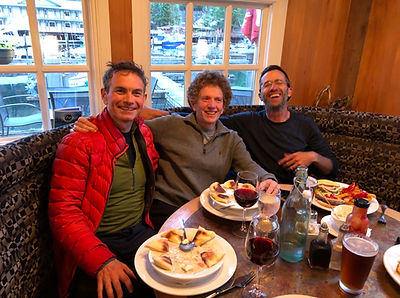Outtake from the Race to Alaska: Arrival at Telegraph Cove
Read the full story in the Oct.-Nov. issue of Hana Hou!
This story was awarded 2019 First Place for Long Form Feature Writing by the Hawaii Society of Professional Journalists.

It was a dream assignment: Follow the Race to Alaska (R2AK), a 750-mile odyssey up the Inside Passage through a remote wilderness of forest and fjord that John Muir described as “the very paradise of the poets, the abode of the blessed.”
From the get-go, photographer Dana Edmunds and I adopted the R2AK spirit—a celebration of “tradition, exploration, and the lawless self-reliance of the gold rush” that shunned convenience and security. How else would we follow a race (without a prohibitively expensive charter boat) in unfamiliar territory that has a three-week-long finish line, includes two border crossings, and whose participants would be scattered over hundreds of miles?
In total we hopped aboard 20 boats, flew on seven planes, drove 805 miles in two rental cars, and even rode a funicular. The City of Port Townsend, Visit Ketchikan, and Destinations BC and partners provided (with no promise of media coverage) lodging in eight towns, and we ordered fish and chips in every one. We crossed paths with 28 species of wildlife and forged bonds with countless, good-hearted humans.
Our trip went something like this.
Me, consulting the dopamine-inducing Race Tracker app: They’ll be here any minute.
Dana: Let’s go!
Us, to a couple walking by: Is there a trail that goes up to the point over there?
Guy: We only went as far as the lookout…
We speed-walk to the lookout. No boats in sight. We continue down a gravel path toward some homes on the water and come face-to-face with a deer. I point out a pile of bear dung.
Me, tiptoeing up a driveway: This one looks like it has an amazing view.
Dana: Someone’s in the kitchen.
Me: Uh, excuse me, hi! We’re, uh, following this boat race and there’s a team that’s about to pass your house. Do you mind if we take a look?
Lady of the house in black dress, sipping wine: Oh, the Vancouver 360?
Me: No. Race to Alaska. They go all the way to Ketchikan!
Lady in black: Wow. Sure. Thanks for asking.
She escorts us to her backyard and a sunset panorama of Johnstone Strait, brings out two cans of beer, and introduces us to her husband who is amping over the Raptors’ lead in Game 5 of the NBA playoffs. While we wait, Jonathan, a kayak guide we met that morning, paddles by. He waves hello, and we feel like locals. An animal—a porpoise?—breaks the water’s glassy surface and dives back down.
Lady in black: It’s a minke. Minkes travel in threes. See?
Just then, the three-person crew of Team Ripple glides into the scene on their Santa Cruz 27’, sails furled. Quiet as a movie set, we hear each other plainly.
Chris Watt: What’s the score? Give us the play-by-play!
Dana: Toronto is up, 101 to 97 with three minutes left.
Christophe Credico, pumping his legs on the pedal drive: You guys have pretty marvelous views here.
Dana: Uh-oh. Golden State took the lead!
The minkes surface again. Ripple rounds the entrance to Telegraph Cove. With a quick goodbye, Dana dashes off to get the shot—one of six occasions he sprinted for a photo.
Me, after talking story for another five minutes: Thank you! We had a great time.
Lady in black: Good luck!
Me, quietly but not that quietly as I return to the marina: Hey bear, hey bear.
We regroup at the restaurant. Over blackened halibut and Killer Whale pale ales, Team Ripple recounts a terrifying near-collision with a tugboat, pedaling the wrong direction in the dark, and ramming into a shoal.
“There’s this tension about the inevitability that things will go wrong,” Chris explains. “Your job is to minimize the probability of those things going wrong, but at the same time you have to maintain an acceptance that things will go wrong.”
Marjory Stewart, the 60-year-old captain who discovered sailing at 50, chimes in, “You need certain skills, but far more than that you need resolve and the ability to suffer cheerfully.”
After dinner Christophe takes a hot shower and toilet paper, shampoo, and wet wipes to go. Chris and Marge choose sleep over hygiene. At 3am, they’re off again.
In Hawai‘i, I had compiled tons of notes: in-depth, pre-race interviews; biographies of 19th century Hawaiians in the Pacific Northwest who worked in the fur trade; voyaging canoe Hawaiiloa’s 1995 sail along the Inside Passage; past race anecdotes, like the crew that found a bottle of ashes of someone who wanted to sail forever and carried him to Ketchikan. None of these made it into the final draft, a saga that had to unfold on its own.
Each team’s story is “different in the telling, but matching the same rhythms,” says race boss Daniel Evans, and they all shape the truth that is Race to Alaska—a hard-earned validation of adventure that seduces everyone involved.
“You can’t come all the way up through Bella Bella and all these places and not be some more romantic person than you were when you left,” Team Pitoraq’s J.T. Hammill insists. “There’s a lot of nature involved and a lot of good friendship on board these boats.”
Team Hana Hou was equally affected.
Text from Dana after returning to Hawai‘i: Checked the Tracker this morning even though I knew that nobody was home.
I didn’t say so, but I did, too.

Videos: Team Ripple pedals up Johnstone Strait toward Telegraph Cove.
Photos (top to bottom): Photographer Dana Edmunds captures the view from a lookout above Telegraph Cove; Hey deer!; Chris, Marjorie, and Christophe enjoy a hot meal one week into the Race to Alaska; the cozy boardwalk community of Telegraph Cove.

